
7 minute read
A LEGEND REBORN
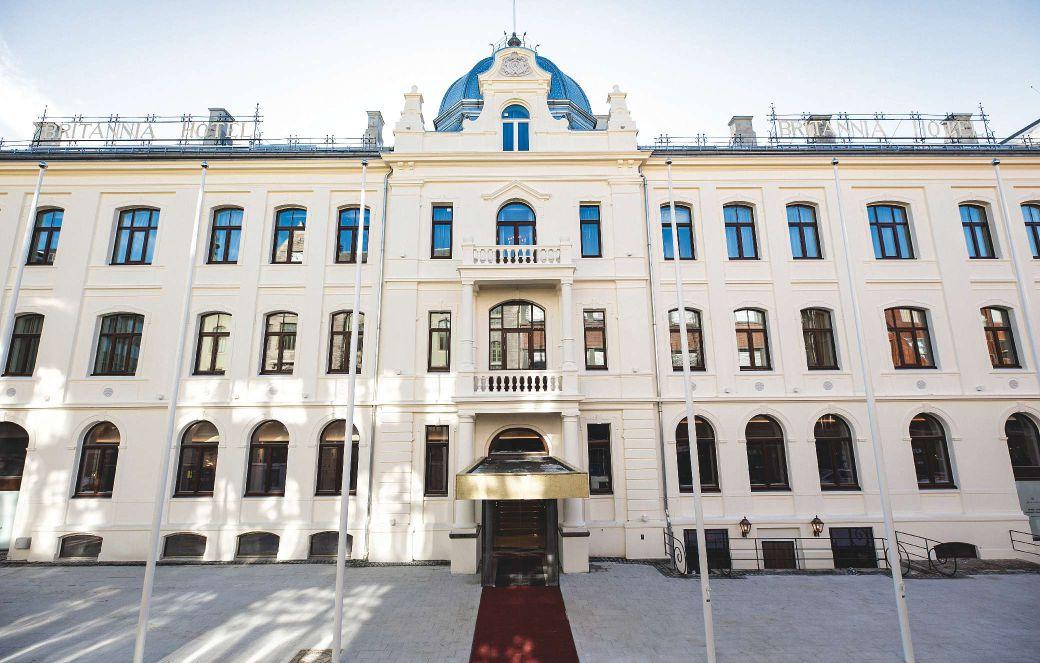
Britannia Hotel in Trondheim, Norway
Opened in the late 1800s as a haven for well-heeled Brits, following a $160 million renovation, the historic Britannia Hotel in Trondheim, Norway is poised to define Norwegian hospitality for luxury travelers well into the next century.
Written by Bridget Williams
Warm and fuzzy feelings distilled from childhood memories can sometimes percolate in the subconscious and impact our lives years later, as the re-opening of the Britannia Hotel in Trondheim, Norway attests. At the tender age of 14, Trondheim native Odd Reitan, now a self-made billionaire, resolved to one day own the world's most northerly "palace" hotel, first opened in 1870. Reitan has remarked fondly of being warmly welcomed into the grand confines of the hotel's glass-domed Palmehaven dining hall on special occasions as a young boy. As a present-day visitor, it is easy to imagine Reitan as a wide-eyed boy surveying the voluminous space, first unveiled in 1918 as a magical touch of the tropics in this most non-tropical of places.
After acquiring the Britannia, Reitan knew that too much nostalgia could be stifling. The multi-year, $160 million renovation he orchestrated preserved the hotel's most significant historical attributes while adding amenities to lure the next generation of tastemakers with an eye for luxury.
Commanding a city block in the center of this pristine city, located just 60 miles south of the Arctic Circle, the juxtaposition of old and new is apparent as soon as you enter the Britannia's lobby. Awash in Italian marble, dotted with gleaming crystal chandeliers, and featuring art by contemporary Scandinavian artists, the décor strikes just the right balance between masculine and feminine. It reminded me of a finely tailored gray pinstriped suit dressed with a pink silk pocket square. Just past a dramatically scaled staircase that conjures many a moment of grand arrival over the years is a bank of high-tech elevators that transport guests quickly and quietly between floors. Colors of the carpet runners that line corridor on each floor dissolve from grey to blush and cream, reminding me of the way the sun gradually dissipates the marine layer. A member of The Leading Hotels of the World, each of the 257 rooms and suites boast Carrara marble bathrooms and handmade beds by renowned Swedish company Hästens, the latter of which speaks to the hotel's no-expense-spared attention to detail. The bed in my two-floor suite provided a sleep so deep I awoke with the folds of my luxurious pillowcase imprinted upon my cheek.
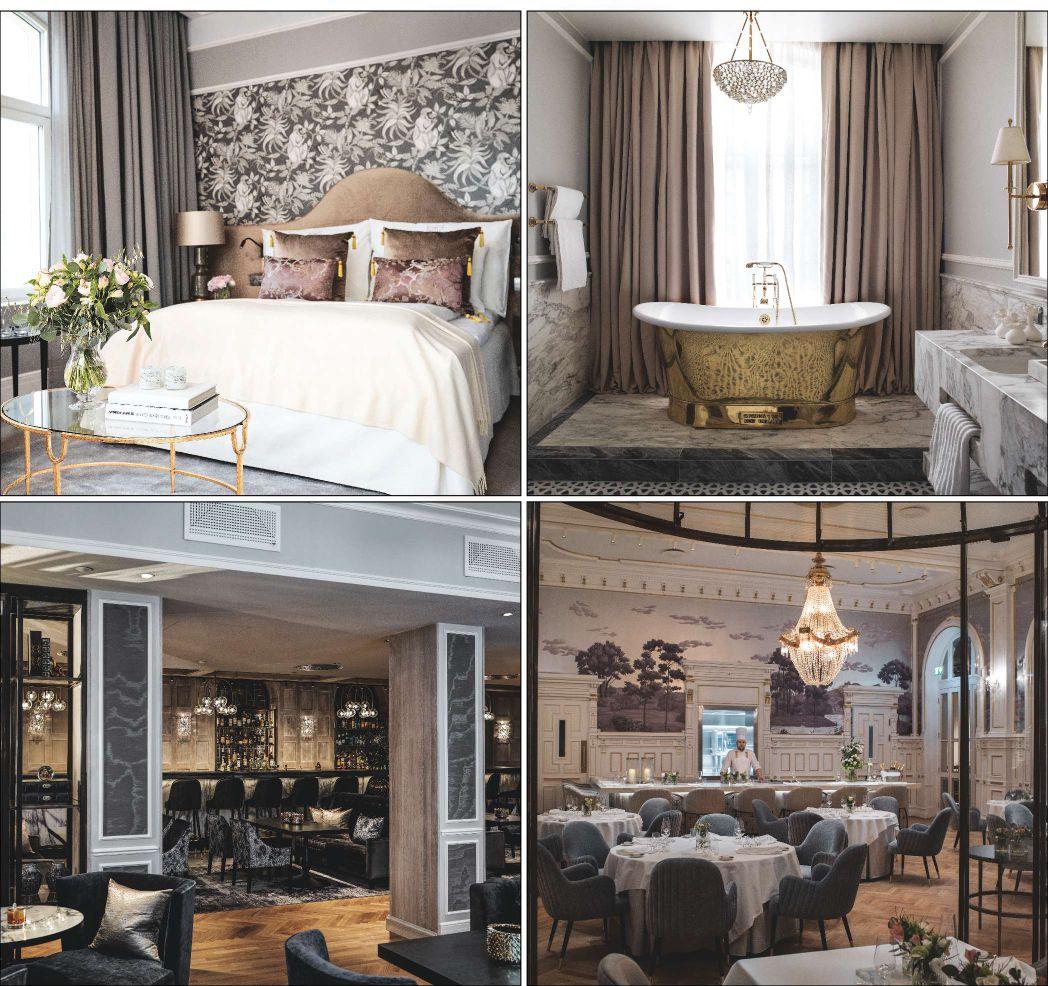
Bottom Left: Britannia Bar Photo by James Eric Hensley. Bottom Right: View from the chambre séparée at Speilsalen
Standing on the balcony of my room, I was able to detect the subtle scent of the briny Norwegian Sea that wafts over the rooftops of this fjord town. By a lucky coincidence, my visit coincided with Syttende Mai, or Norwegian Constitution Day (May 17), so from morning until night, I was treated to an endless parade of parades. Similar to 4th of July but dressier, the holiday was wonderfully devoid of any shows of military force or political grandstanding (except for the Star Wars club marching in stormtrooper garb). Everyone was attired in traditional dress or their Sunday best, singing, waving flags, and eating copious amounts of ice cream. I truly believed that this might be the happiest place on earth that day.
Of the eight Michelin-starred restaurants in Norway, two are in Trondheim: Fagn and Credo. Britannia's Executive Chef Christopher Davidsen, a 2017 Bocuse d'Or silver medalist, has his eyes on a star for Speilsalen, the most elevated among the six restaurants and bars at the Britannia. An immersive experience for the senses, patrons are treated to multi-course meals that are planned, prepared, plated, and presented with expert precision. A former ballroom, the dining room is outfitted with original scenic wallpaper, crystal chandeliers, and a pair of glass greenhouselike chambre séparée that accommodate up to 12 guests each. Befitting each course is custom Christofle china adorned with patterns culled from the hotel's archives. "My philosophy is to use high technique with local ingredients and a twist of flavors from around the world," said Davidsen of the menu at Speilsalen. Like the Britannia's owner, nostalgia informs the cuisine, allowing Davidsen to take favorite ingredients and treasured dining experiences from his childhood and reinterpret them as culinary fine art. Four-time Norwegian wine sommelier champion Henrik Dahl Jahnsen oversees the wine pairings. "When our doors open, the curtain goes up, and the show can begin," Davidsen remarked.
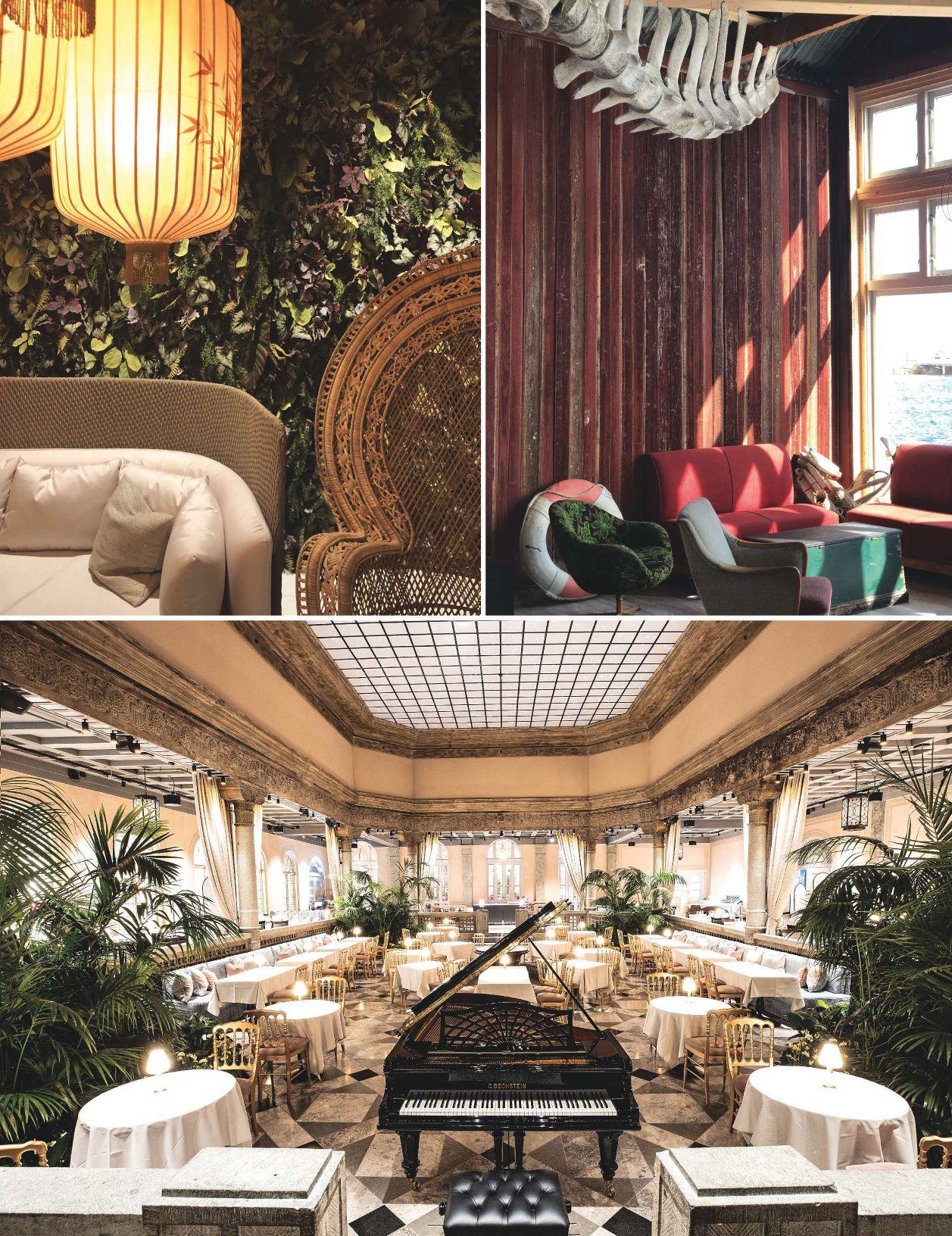
Top left: Britannia Spa / Top right: The event space at Terna Brygge, located on the island of Sula.
With a 10,000-bottle wine cellar, the hotel's Vinbaren is heaven on earth for oenophiles. Descending into the cellar via a stairwell lined with mirrors, reminded me of images of Coco Chanel's Paris apartment. The wine list includes both established and emerging regions, and Jahnsen said their aim is that each guest can find a bottle from "home." The house vintage Champagne from Maison Ayala is exclusive to the Britannia and pays homage to a partnership that spans more than a century.
As a self-professed cocktail connoisseur, I was partial to the fanfare at the chic Britannia Bar, where the sometimes weird and always wonderful cocktail menu literally encompasses smoke and mirrors. Head bartender Øyvind Lindgjerde spent three months devising the cocktail menu, even building a bar in his home to use as a laboratory. The bar's inventory includes 25 types of aquavit, a flavored spirit produced in Nordic countries since the 15th century.
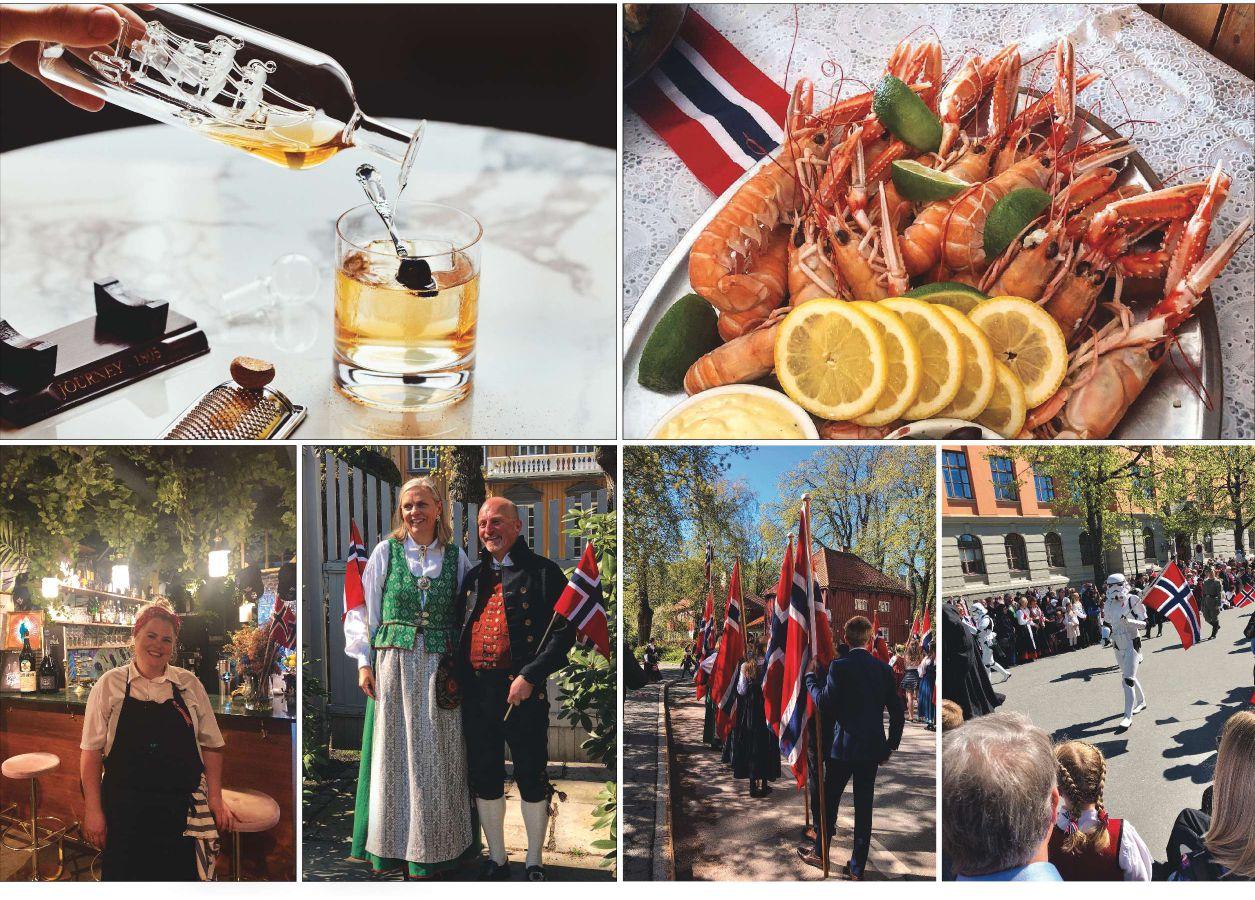
Top left: Head bartender Øyvind Lindgjerde spent three months devising the cocktail menu for the Britannia Bar. Photo by Lars Petter Pettersen. Bottom Left: Reneé Fagerhøi, chef/owner of Bula restaurant Bottom center and right: Traditional attire is popular on Syttende Mai, Norway's Constitution Day.
Wellness facilities include a massive fitness room, an indoor swimming pool, and a spa. The latter encompasses five treatment rooms, snow-bathing, an ice bath, several types of saunas, and a whirlpool positioned under a ceiling designed to replicate the Northern Lights.
Trondheim is a very walkable city, and during the summer months, explorations on foot can stretch into the wee hours under the midnight sun. After a sublimely satiating feast at Speilsalen, rather than head to bed on a full stomach, I changed into my walking clothes and set out to explore the city.
I began my trek with a stop at the exquisite and ancient Nidaros Cathedral, the northernmost medieval cathedral in the world before moving on to admire the colorful buildings lining the canals. By the time I reached the top of a near-vertical street that is home to the world's only bicycle lift, I was nearly breathless. Near the top was my final destination: a large park surrounding the Kristiansten Fortress. By the time I arrived, it was approaching the midnight hour; yet the light was as bright as the spirits of those gathered here to walk their dog, listen to music, picnic, or just soak up the sweeping views of the city and the sea. It was one of those magical travel moments I won't soon forget.
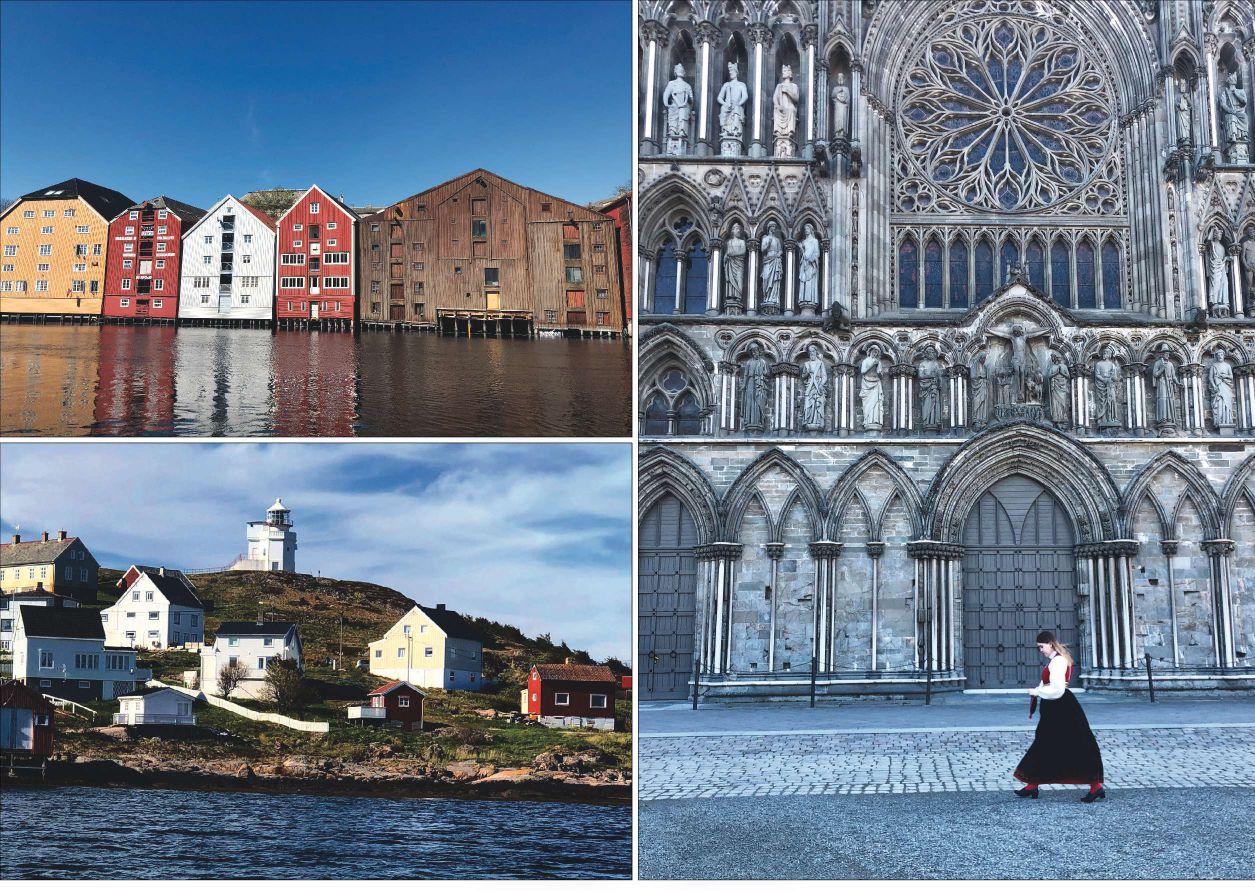
Top left: Wharf buildings along the river Nidelven in Trondheim Bottom left: The island of Sula is home to 60 year-round residents. Right: The Nidaros Cathedral is the northernmost medieval cathedral in the world.
Also memorable were meals at Bula Bistro (bulabistro.no) and Rom & Kjøkken (toromogkjokken.no). With a red bandana tied around her head like a modern-day Rosie the Riveter, Reneé Fagerhøi, the chef/owner of Bula, turns out food as lively colorful as her personality. Growing up on what she describes as a "biodynamic commune with no TV," Fagerhøi said that after becoming a chef, she appreciated the cooking skills picked up as a child. Her ten-course tasting menus are designed to "reflect what's happening in the world," and might encompass everything from pig ears to scallops. "It can be anything as long as it's delicious," she explained.
Outside the city limits, some 5,000 islands beckon. Zipping along the water at up to 67 knots (78mph) aboard an open-air Rigid Inflatable Boat operated by Fjordrafting (fjordrafting.no) was my favorite mode of transport. The jostling and jumping, particularly in areas where the waters were a little choppier, is best described as riding a wooden rollercoaster. For a more sedate sailing, book a fishing or island-hopping tour with Wold KystTransport (woldkysttransport.no/en/). The company owns a spectacular renovated farmhouse, constructed in 1929, on the island of Bogøya, that is available to rent. With just 16 residents on the island, staying here is the epitome of getting away from it all.
Slightly more populated, but still only home to 60 hearty souls year-round, Sula is the largest island in the region. The lightkeeper's house is available to rent from a couple who also operates a small café with offerings made from ingredients foraged on the island's scrubby, windswept hillsides (sulakultur.com). Surprisingly upscale for such a remote place is Terna Brygge (ternabrygge.no), a seasonal restaurant and event space.
If you are longing for langoustine or any of the sea's delicacies, don't miss the "Everything on the Table" spread put on by Ansnes Brygger Restaurant on the island of Ansnes (ansnesbrygger.com). Exactly as it sounds, copious amounts of seafood are accompanied by beer brewed next door. In a country where it's nearly night for four months out of the year, this feast was yet another reminder that Norwegians certainly know how to make hay while the sun shines.
Rooms at the Britannia Hotel start at $250/night and include breakfast at Palmehaven. For more information or reservations, visit Britannia.no/en.

